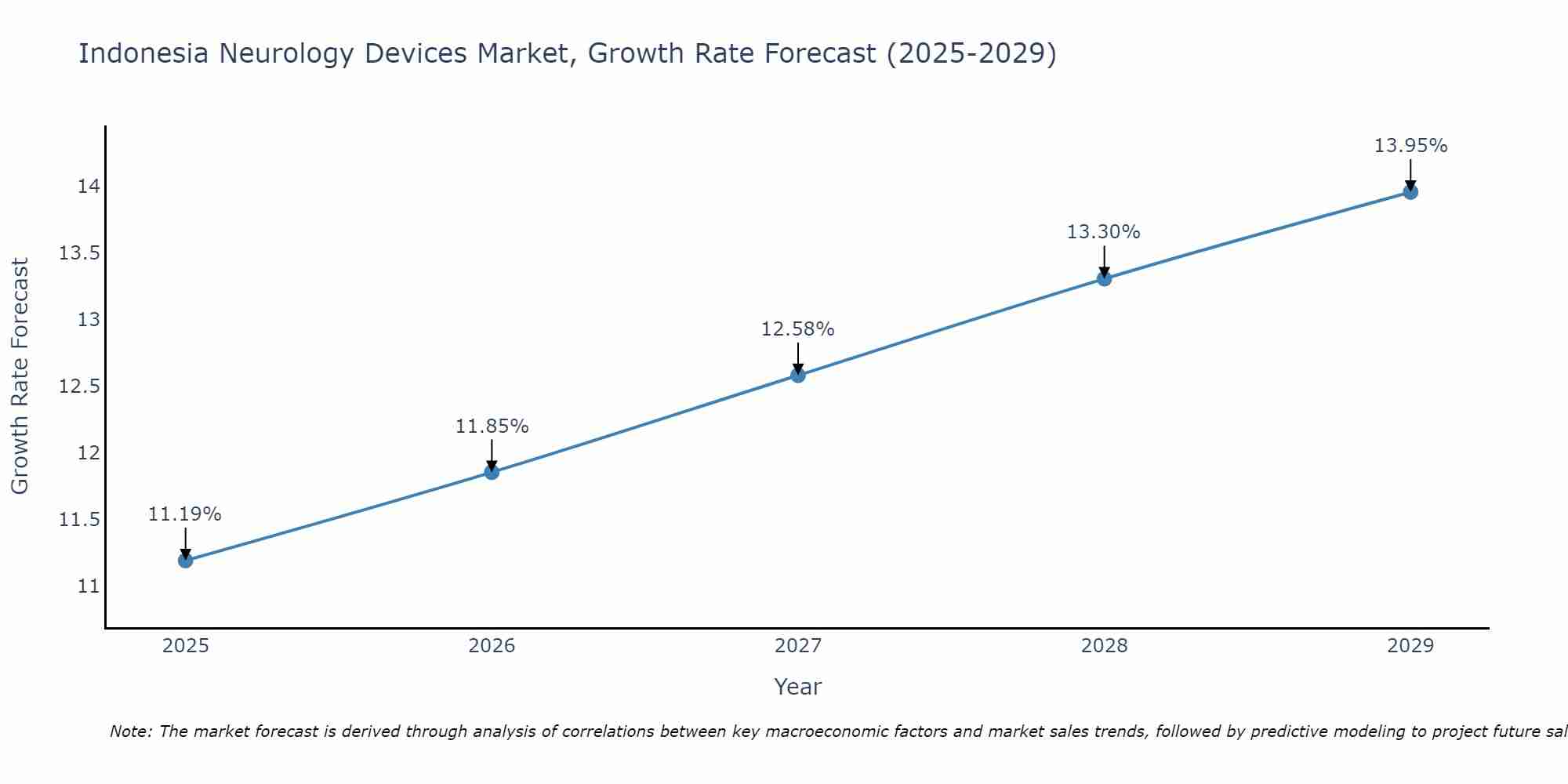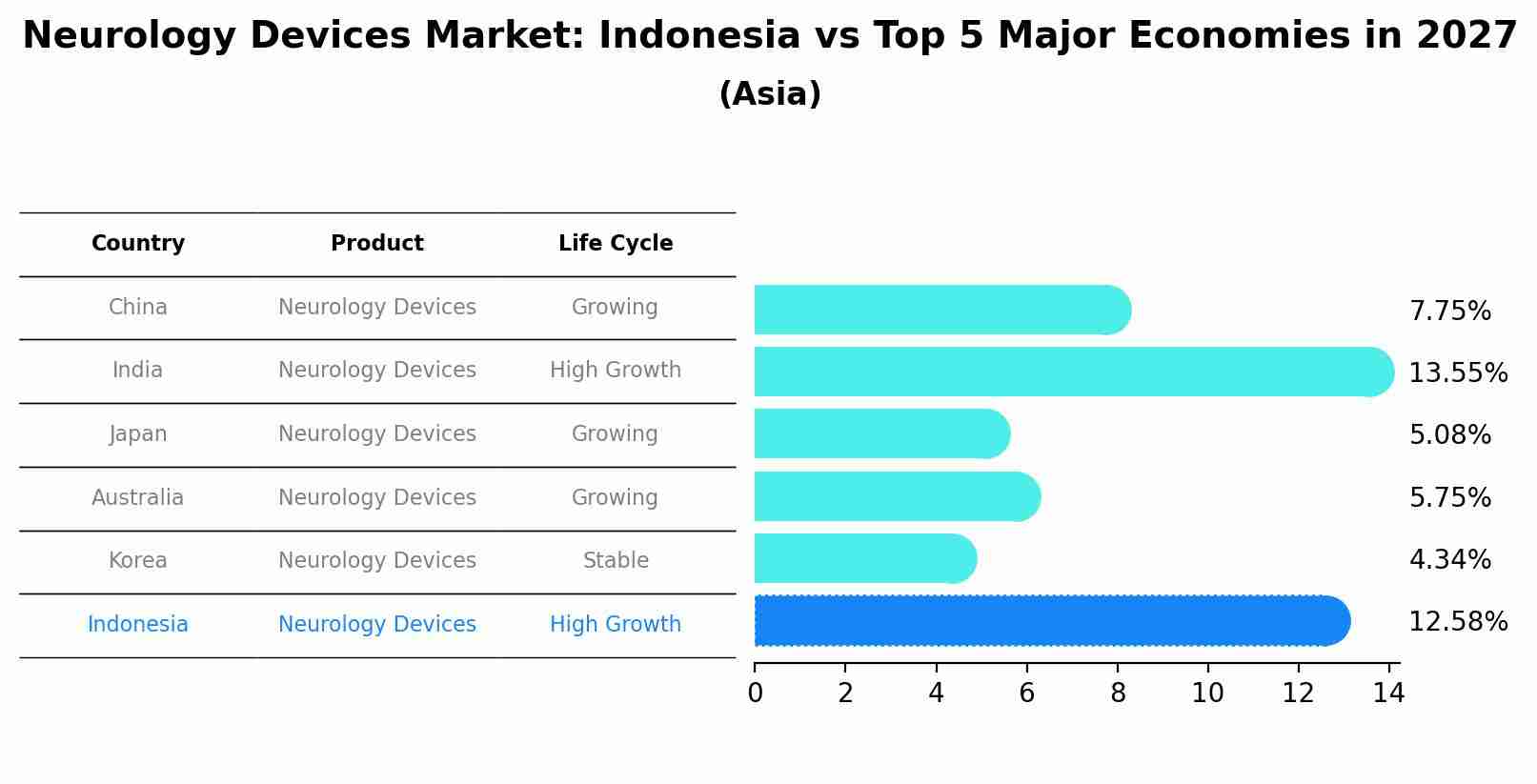Indonesia Neurology Devices Market (2025-2031) Outlook | Share, Companies, Value, Industry, Analysis, Forecast, Trends, Revenue, Growth & Size
| Product Code: ETC367648 | Publication Date: Aug 2022 | Updated Date: Apr 2025 | Product Type: Market Research Report | |
| Publisher: 6Wresearch | No. of Pages: 75 | No. of Figures: 35 | No. of Tables: 20 | |
Indonesia Neurology Devices Market Size Growth Rate
The Indonesia Neurology Devices Market is poised for steady growth rate improvements from 2025 to 2029. The growth rate starts at 11.19% in 2025 and reaches 13.95% by 2029.

Neurology Devices Market: Indonesia vs Top 5 Major Economies in 2027 (Asia)
The Neurology Devices market in Indonesia is projected to grow at a high growth rate of 12.58% by 2027, highlighting the country's increasing focus on advanced technologies within the Asia region, where China holds the dominant position, followed closely by India, Japan, Australia and South Korea, shaping overall regional demand.

Indonesia Neurology Devices Market Synopsis
The neurology devices market in Indonesia is steadily expanding due to an aging population and a growing awareness of neurological disorders. The demand for devices such as EEG machines, neurostimulation devices, and neurodiagnostic equipment is on the rise. This growth is also supported by investments in healthcare infrastructure and the presence of key market players. As the healthcare sector continues to evolve, the neurology devices market is expected to witness sustained growth.
Drivers of the Market
The Indonesia Neurology Devices market is expected to witness significant growth in the coming years, primarily driven by the increasing prevalence of neurological disorders in the country. Factors such as a growing aging population, changing lifestyles, and rising awareness about neurological conditions are contributing to the demand for advanced neurology devices. Additionally, technological advancements in neuroimaging, electroencephalography (EEG), and neurostimulation devices are enhancing diagnosis and treatment options for patients. The government`s initiatives to improve healthcare infrastructure and access to neurological care services are also propelling market growth.
Challenges of the Market
The neurology devices market in Indonesia faces several challenges. First, there is a shortage of specialized healthcare professionals with expertise in neurology, limiting the adoption and effective use of neurology devices. Second, the market may encounter pricing pressures, as many healthcare facilities, especially public ones, have limited budgets for purchasing expensive neurology equipment. Third, regulatory approvals and quality certifications for neurology devices can be time-consuming and complex, delaying market entry for manufacturers. Additionally, staying updated with the latest advancements in neurology technology is crucial to meet the evolving healthcare needs of the country.
COVID-19 Impact on the Market
The COVID-19 pandemic had a notable impact on the neurology devices market in Indonesia. Hospitals and clinics faced disruptions in regular patient care services, leading to delayed or postponed elective procedures and diagnostics. This, in turn, affected the demand for neurology devices. However, the emphasis on telemedicine and remote monitoring solutions increased during the pandemic, providing opportunities for growth in this market segment.
Key Players in the Market
The Indonesia neurology devices market is witnessing growth with increasing awareness and healthcare investments in neurological disorders. Key players like Medtronic plc, Abbott Laboratories, and Siemens Healthineers are offering innovative neurology devices, including neurostimulation systems and diagnostic equipment. The rising prevalence of neurological conditions and the focus on improving patient care are driving the market`s expansion.
Key Highlights of the Report:
- Indonesia Neurology Devices Market Outlook
- Market Size of Indonesia Neurology Devices Market, 2024
- Forecast of Indonesia Neurology Devices Market, 2031
- Historical Data and Forecast of Indonesia Neurology Devices Revenues & Volume for the Period 2021-2031
- Indonesia Neurology Devices Market Trend Evolution
- Indonesia Neurology Devices Market Drivers and Challenges
- Indonesia Neurology Devices Price Trends
- Indonesia Neurology Devices Porter's Five Forces
- Indonesia Neurology Devices Industry Life Cycle
- Historical Data and Forecast of Indonesia Neurology Devices Market Revenues & Volume By Product for the Period 2021-2031
- Historical Data and Forecast of Indonesia Neurology Devices Market Revenues & Volume By Neurostimulation Devices for the Period 2021-2031
- Historical Data and Forecast of Indonesia Neurology Devices Market Revenues & Volume By Neurosurgery Devices for the Period 2021-2031
- Historical Data and Forecast of Indonesia Neurology Devices Market Revenues & Volume By Interventional Neurology Devices for the Period 2021-2031
- Historical Data and Forecast of Indonesia Neurology Devices Market Revenues & Volume By Cerebrospinal fluid management devices for the Period 2021-2031
- Historical Data and Forecast of Indonesia Neurology Devices Market Revenues & Volume By Others for the Period 2021-2031
- Historical Data and Forecast of Indonesia Neurology Devices Market Revenues & Volume By End User for the Period 2021-2031
- Historical Data and Forecast of Indonesia Neurology Devices Market Revenues & Volume By Hospitals for the Period 2021-2031
- Historical Data and Forecast of Indonesia Neurology Devices Market Revenues & Volume By Ambulatory surgery centers for the Period 2021-2031
- Historical Data and Forecast of Indonesia Neurology Devices Market Revenues & Volume By Neurology clinics for the Period 2021-2031
- Indonesia Neurology Devices Import Export Trade Statistics
- Market Opportunity Assessment By Product
- Market Opportunity Assessment By End User
- Indonesia Neurology Devices Top Companies Market Share
- Indonesia Neurology Devices Competitive Benchmarking By Technical and Operational Parameters
- Indonesia Neurology Devices Company Profiles
- Indonesia Neurology Devices Key Strategic Recommendations
Frequently Asked Questions About the Market Study (FAQs):
- Single User License$ 1,995
- Department License$ 2,400
- Site License$ 3,120
- Global License$ 3,795
Search
Related Reports
- Middle East OLED Market (2025-2031) | Outlook, Forecast, Revenue, Growth, Companies, Analysis, Industry, Share, Trends, Value & Size
- Taiwan Electric Truck Market (2025-2031) | Outlook, Industry, Revenue, Size, Forecast, Growth, Analysis, Share, Companies, Value & Trends
- South Korea Electric Bus Market (2025-2031) | Outlook, Industry, Companies, Analysis, Size, Revenue, Value, Forecast, Trends, Growth & Share
- Vietnam Electric Vehicle Charging Infrastructure Market (2025-2031) | Outlook, Analysis, Forecast, Trends, Growth, Share, Industry, Companies, Size, Value & Revenue
- Vietnam Meat Market (2025-2031) | Companies, Industry, Forecast, Value, Trends, Analysis, Share, Growth, Revenue, Size & Outlook
- Vietnam Spices Market (2025-2031) | Companies, Revenue, Share, Value, Growth, Trends, Industry, Forecast, Outlook, Size & Analysis
- Iran Portable Fire Extinguisher Market (2025-2031) | Value, Forecast, Companies, Industry, Analysis, Trends, Growth, Revenue, Size & Share
- Philippines Animal Feed Market (2025-2031) | Companies, industry, Size, Share, Revenue, Analysis, Forecast, Growth, Outlook
- India Lingerie Market (2025-2031) | Companies, Growth, Forecast, Outlook, Size, Value, Revenue, Share, Trends, Analysis & Industry
- India Smoke Detector Market (2025-2031) | Trends, Share, Analysis, Revenue, Companies, Industry, Forecast, Size, Growth & Value
Industry Events and Analyst Meet
Our Clients
Whitepaper
- Middle East & Africa Commercial Security Market Click here to view more.
- Middle East & Africa Fire Safety Systems & Equipment Market Click here to view more.
- GCC Drone Market Click here to view more.
- Middle East Lighting Fixture Market Click here to view more.
- GCC Physical & Perimeter Security Market Click here to view more.
6WResearch In News
- Doha a strategic location for EV manufacturing hub: IPA Qatar
- Demand for luxury TVs surging in the GCC, says Samsung
- Empowering Growth: The Thriving Journey of Bangladesh’s Cable Industry
- Demand for luxury TVs surging in the GCC, says Samsung
- Video call with a traditional healer? Once unthinkable, it’s now common in South Africa
- Intelligent Buildings To Smooth GCC’s Path To Net Zero













